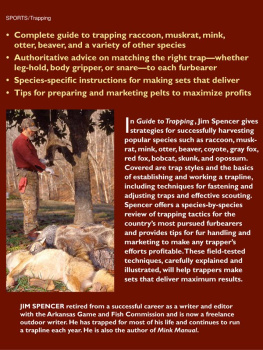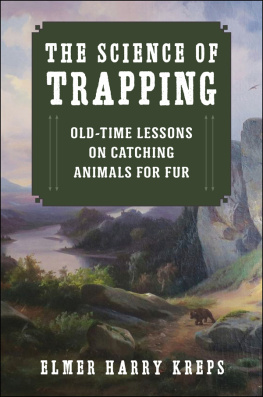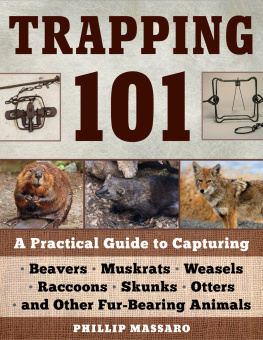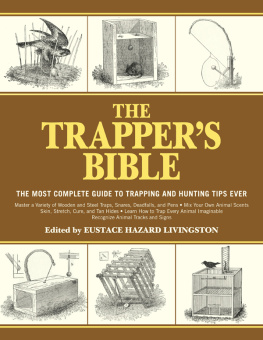Jim Spencer - Guide to Trapping
Here you can read online Jim Spencer - Guide to Trapping full text of the book (entire story) in english for free. Download pdf and epub, get meaning, cover and reviews about this ebook. year: 2007, publisher: Stackpole Books, genre: Home and family. Description of the work, (preface) as well as reviews are available. Best literature library LitArk.com created for fans of good reading and offers a wide selection of genres:
Romance novel
Science fiction
Adventure
Detective
Science
History
Home and family
Prose
Art
Politics
Computer
Non-fiction
Religion
Business
Children
Humor
Choose a favorite category and find really read worthwhile books. Enjoy immersion in the world of imagination, feel the emotions of the characters or learn something new for yourself, make an fascinating discovery.
- Book:Guide to Trapping
- Author:
- Publisher:Stackpole Books
- Genre:
- Year:2007
- Rating:3 / 5
- Favourites:Add to favourites
- Your mark:
- 60
- 1
- 2
- 3
- 4
- 5
Guide to Trapping: summary, description and annotation
We offer to read an annotation, description, summary or preface (depends on what the author of the book "Guide to Trapping" wrote himself). If you haven't found the necessary information about the book — write in the comments, we will try to find it.
Guide to Trapping — read online for free the complete book (whole text) full work
Below is the text of the book, divided by pages. System saving the place of the last page read, allows you to conveniently read the book "Guide to Trapping" online for free, without having to search again every time where you left off. Put a bookmark, and you can go to the page where you finished reading at any time.
Font size:
Interval:
Bookmark:
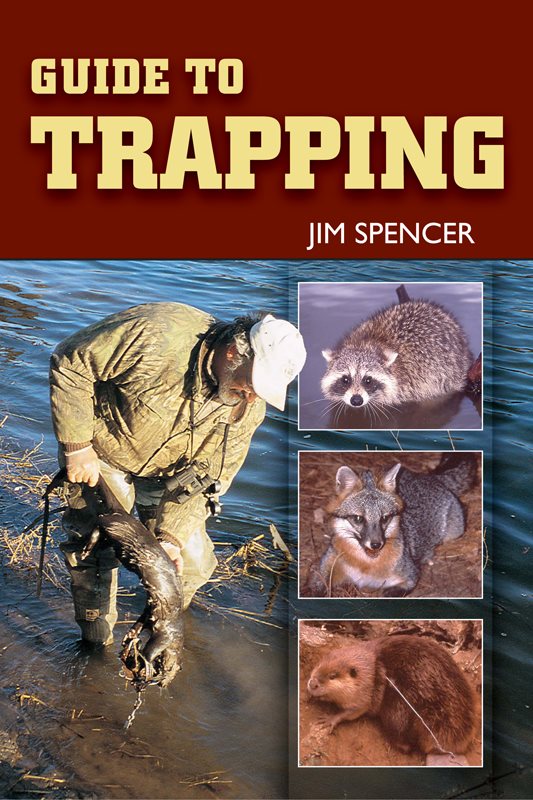
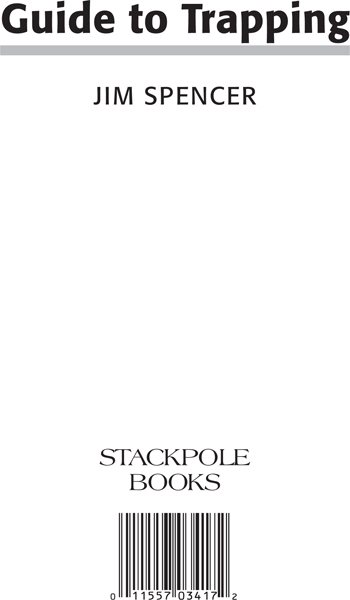
To Jill.
No one who knows her will need to ask why.
Copyright 2007 by Jim Spencer
Published by
STACKPOLE BOOKS
5067 Ritter Road
Mechanicsburg, PA 17055
www.stackpolebooks.com
All rights reserved, including the right to reproduce this book or portions thereof in any form or by any means, electronic or mechanical, including photocopying, recording, or by any information storage and retrieval system, without permission in writing from the publisher. All inquiries should be addressed to Stackpole Books, 5067 Ritter Road, Mechanicsburg, Pennsylvania 17055.
First edition
Cover photographs by Bill Bradbury, Jill Easton, and Jim Spencer
Cover design by Wendy Reynolds
Photos by author except on the following pages: Jill Easton:
Illustrations by Caroline Stover
Library of Congress Cataloging-in-Publication Data
Spencer, Jim, 1947
Guide to trapping / Jim Spencer.1st ed.
p. cm.
Includes .
ISBN-13: 978-0-8117-3417-2
ISBN-10: 0-8117-3417-X
1. Trapping. I. Title.
SK283.S56 2007
639'.1dc22
2006038366
eBook ISBN: 9780811745260
Contents
Foreword
Ive known Jim Spencer a long, long time. Exactly when and where we first met, I cant remember. A lot of water has gone under both our bridges since then, some of it flavored with the bourbon weve shared around hundreds of campfires. I do know that when we met, neither of us had gray in our beards, and that was eons ago.
The reason we met, though, is clear and certain. Both of us are hook-and-bullet writers, which makes both of us strange birds, and strange birds tend to flock together. We both live in Arkansasalways haveso it was inevitable our paths would cross.
Actually, our paths didnt cross; they merged. In the 1980s, we both were hired by the states natural resources agency as writers and public-relations types, and during most of our almost twenty-year tenure there, we worked together writing and editing the agencys conservation magazine. Everything Jim wrote, I edited, and everything I wrote, Jim edited. We also edited scores of articles by other writers. We often spent days brainstorming about the proper way to tackle a conservation-related issue of importance, and though we butted heads about as often as we agreed, in the end, we produced a magazine both of us will always be proud of.
I tell you these things so youll know why Im qualified to enlighten you about the man whose words you are about to read. I can read a single sentence Jim has written and know immediately the words are his. His style is that unique. And I can say without hesitation that very few outdoor writers possess his skill for wordsmithing. The sentences he crafts define us as outdoorsmen. They are magical and unforgettable and insightful all at once. When you read Jim Spencer, you are certain to become a Jim Spencer fan.
I also can tell you that no man ever loved trapping more than Jim. When I first went with him to run one of his lines, I was astounded. The 200-plus traps were set along a course spanning more than 160 miles and took an entire day, with some dark on each end of it, to check and reset. And the number of furbearers he caught was amazing.
All of us who know Jim well know that come fall, when trapping season begins, hell be hard to find, because every day hell be in the river bottoms or on the mountain ridges, tending his lines. Depending on market and weather conditions, some years he mostly works the water, focusing on mink, muskrats, raccoons, otters, and other wetland furbearers. Other years he concentrates on bobcats, foxes, coyotes, and other animals on the higher ground. Most years he splits it up, doing some of each, because he loves all types of trapping so well he cant bring himself to forego any of it. Thats my take on it, anyway.
Whatever species this modern mountain man goes after, he captures in good numbers. And having done this for decades, devoting hundreds of hours annually to his passion, he has gained a measure of experience few trappers will ever possess. He is probably not the best trapper in the world, but hes the best one I know, and Id put him up against anyone in a head-to-head competition. Not that hed have any of it, you understand; he traps for himself, for the joy of it, for the feeling that, as he told me once around one of those bourbon-sipping campfires, because I feel like Im helping to keep something alive.
This book you are about to read is one more example of Jims striving to keep something alive. No one is more qualified to write a book on trapping, and no one who ever did has done so with Jims flair. Regardless of your skill levelbeginner, veteran, or in betweenyoull do well to follow the advice and examples set forth in the pages that follow. My prediction is not only will you become a better trapper, but also that this book is certain to become a favorite youll return to again and again.
KEITH CATFISH SUTTON
Introduction
Why I Am a Trapper
They tell me I was born too late, that I should have been a mountain man, that I would have fit right in with the buckskin-clad loners who explored this land in their relentless quest for beaver pelts.
They tell me Im an anachronism, that the day of my art has come and gone, that Im a practitioner of an old-fashioned, outdated form of outdoor activity that has no place in the modern world.
They tell me, too, Im a social misfit, that Im a cruel and bloodthirsty perpetrator of an inhuman and inhumane activity, that my fellows and I should be thrown into jail like the criminals we are.
They tell me these things because Im a trapper.
Theyre wrong.
First, I was not born too late, and I would not have made a good mountain man. Sure, Id love to have seen the Ozarks as Friedrich Gerstcker saw them in the 1830s and 1840s, with elk and bison in the cedar glades and a turkey behind every bush. And sometimes I daydream about the things Messrs. Lewis and Clark saw as they ascended the Missouri 200 years ago. John Colter, despite the balloon of legend that surrounds his name, doubtless saw a great many things Id give ten years of my life to see.
But Im too fond of flush toilets, air-conditioning, and Gore-Tex to wish Id been born in the 1700s instead of the 1900s. Take away my insulated waders and my pickup truck and Id wimp out on you in a hurry. Im a Baby Boomer, born in the lap of solid middle-class comfort, and Im not willing to pay the necessary price to step into H. G. Wellss time machine and turn it back a couple notches. Nope. No mountain man here.
Second, Im no more anachronism than anaconda. Its true that trapping is an ancient profession. Its also true that trappers still use the same basic equipment their predecessors used 200 years ago. The opponents of trapping are quite correct when they claim there have been few significant changes in the basic leg-hold steel trap since its invention in medieval times as a device for catching poachers on the lands of European royalty. A Yankee blacksmith named Sewell Newhouse brought quality, consistency, and mass production to the trap-making business in the 1820s, but the basic steel trap is much the same today as it was when days were old and knights were bold.
Rather than use that as a condemnation, though, use it instead as a sign that trapping achieved state-of-the-art technology long before most other forms of outdoor recreation. The fact is, Mr. Newhouse merely refined an already efficient machine in the early 1800s. If he could come back and go with me on my trapline this winter, Newhouse would have no trouble recognizing the tools of the trade, because theyve changed so little in appearance and function.
Next pageFont size:
Interval:
Bookmark:
Similar books «Guide to Trapping»
Look at similar books to Guide to Trapping. We have selected literature similar in name and meaning in the hope of providing readers with more options to find new, interesting, not yet read works.
Discussion, reviews of the book Guide to Trapping and just readers' own opinions. Leave your comments, write what you think about the work, its meaning or the main characters. Specify what exactly you liked and what you didn't like, and why you think so.

